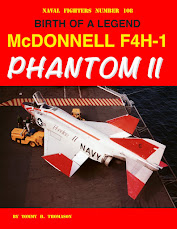Basic AD notes:
1. The vertical fin and rudder were angled three degrees to the left with an an asymmetric airfoil that lifted to the right. See http://tailspintopics.blogspot.com/2017/08/relying-on-museum-pieces-for-accuracy.html
2. The powerplant section including cowl flaps was angled down by three degrees.
The AD-4W was similar to the AD-4 with the following notable exceptions:
1. Addition of a large belly-mounted radome
2. Landing Gear
The landing gear reverted to the AD-1 configuration with no doors covering the retracted wheel. The wheel retracted into a round opening on the underside of the wing aft of the main wing spar. The retraction mechanism folded into a truncated triangular opening forward of the spar similar to this AD-5Q.
Jim Robbins Photo
The catapult hooks were relocated from under the inboard wing to the main landing gear strut in order to provide clearance between the radome and the catapult bridle. This resulted in a different forward-facing landing gear door when one was subsequently added.
Left main landing gear shown above for AD-4W BuNos 124761 and subsequent. Earlier AD-4Ws and all AD-3Ws had a large fixed fairing over the gear-rotation knuckle and no forward-facing door attached to the landing gear strut.
3. Wing
A "stall strip" was added to the leading edge of the right wing only, roughly the maximum width of the well for the gear retraction mechanism.
A fixed slat was added to the leading edge of the outboard wing panels.
(Underside of right wing. Note pitot.)
The outboard wing panel stores pylons and all guns were deleted although the openings for the attach points for the pylons appear to have been retained. Early type AD pylons were retained on the inner wing panels to carry external fuel tanks.
4. The oil cooler outlet was relocated from the belly to each side of the fuselage just aft of the cowl flaps.
5. Addition of a fairing aft of a new sliding cockpit canopy to house electronic-component cooling system (the windscreen remained the same).
Note the inlet and outlet providing air for a radiator at the aft end of the turtle back.
6. Addition of crew-compartment doors on each side of the mid fuselage. Early AD-4Ws had a flush window; later ones (BuNo 124761 and subsequent had a bulged window in the door).
7. The "armor" plate added during AD-4 production on the side and belly of the forward fuselage was not installed.
8. Auxiliary vertical fins were added to the horizontal stabilizer to restore directional stability lost with the addition of the radome. Both were angled to left by three degrees like the vertical fin.
(Before you whinge about the dubiousness of photo interpretation, which would normally be appropriate, this fin orientation is stated in the Douglas AD-4W maintenance manual, with a caution that they are not therefore interchangeable.)
9. The dive brakes were deleted. Unlike the AD-5W, the lower speed brake well was covered over.
10. There were three different avionics suites during the production run of the AD-4W. See https://tailhooktopics.blogspot.com/2019/11/douglas-ad-4waew1-antenna-configurations.html
Unfortunately, even Douglas drawings of its ADs are not necessarily accurate in shape. This is a work in process using Douglas drawings attempting to define the location and shape of the crew door and the electronics turtle back.
All published AD-4W drawings are at best a close approximation of the unique details.
Some modelers have express interest in detailing the cheap seats area;















No comments:
Post a Comment